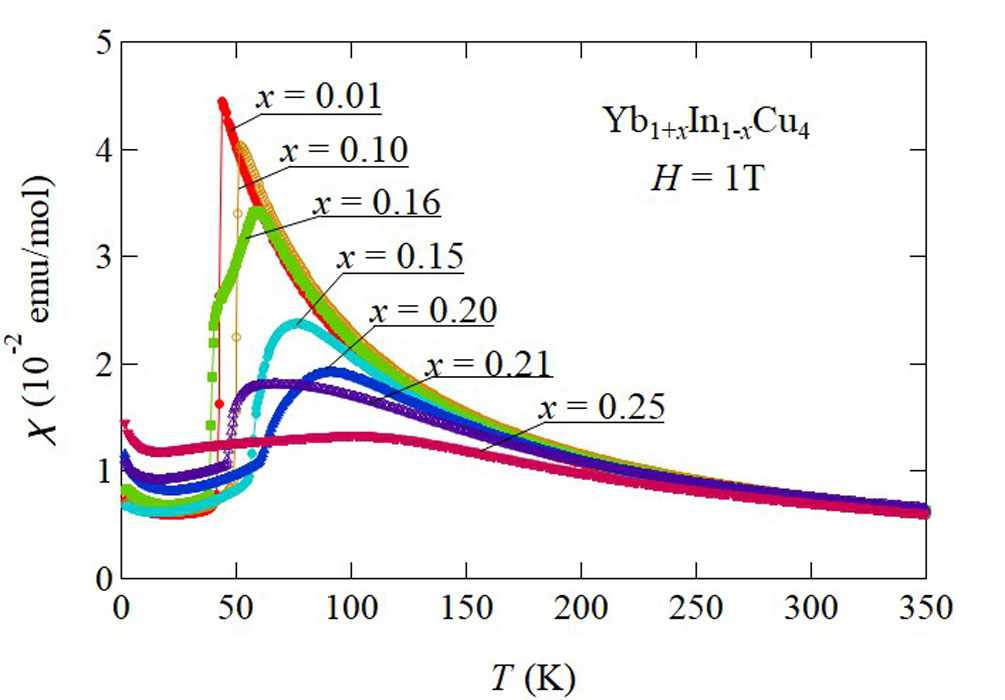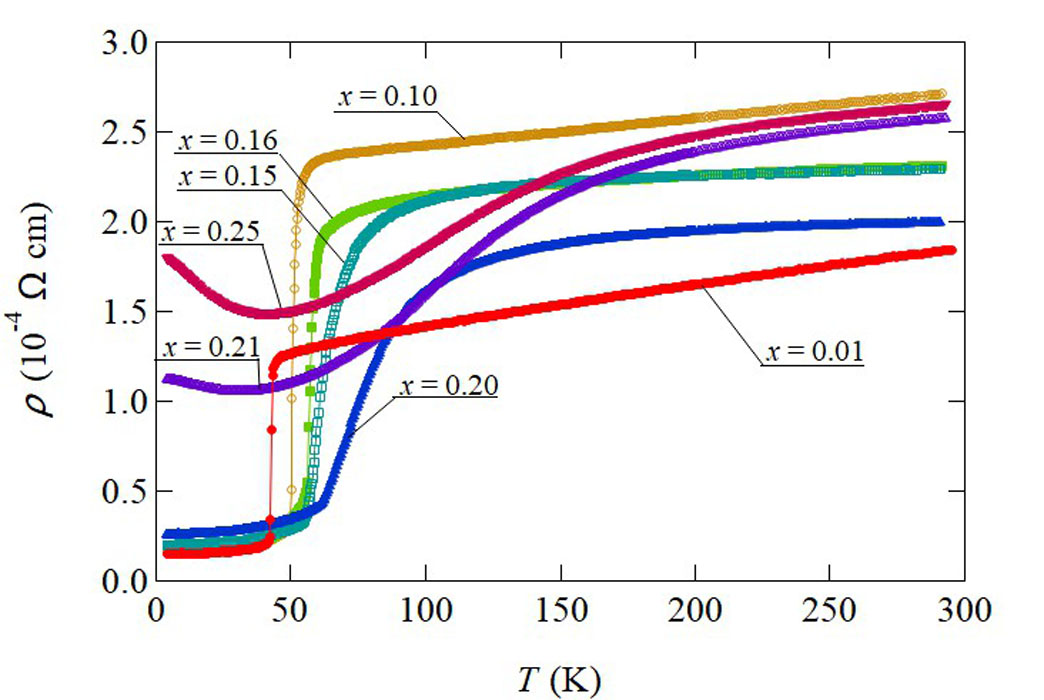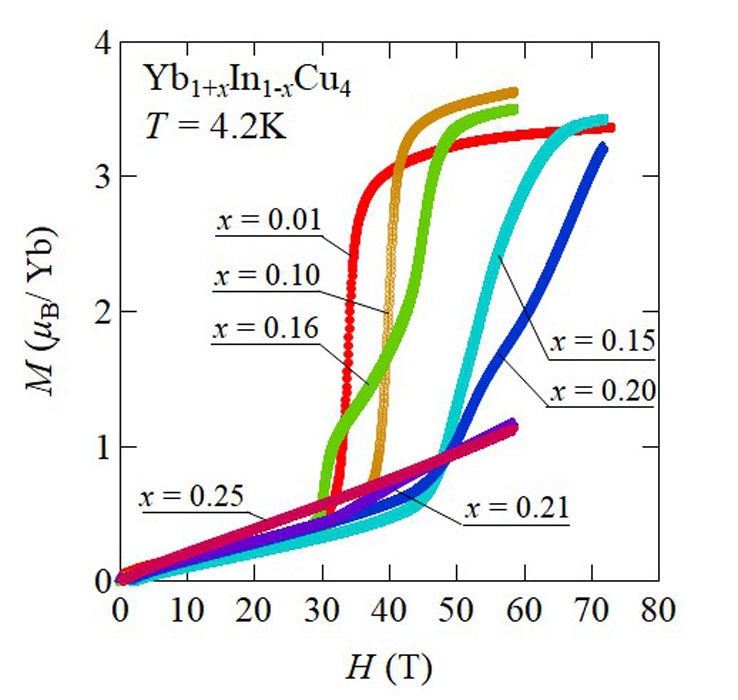Two-step Magnetic Anomaly in the High Field Magnetization Process in Yb1+xIn1−xCu4
S. Yamanaka, A. Matsuo, and C. Michioka
The intermetallic compound YbInCu4 exhibits a first-order valence transition at 42 K under ambient pressure; Ytterbium ions have trivalent local moments in the high-temperature phase, and they become a mixed-valence state of an average valence of 2.9 in the low-temperature phase [1, 2]. In addition, a magnetic field-induced valence transition also occurs below 42 K with the transition field of ~30 T [3, 4]. To clarify the mechanism of the valence transition, substitution effects in Yb or In site have been extensively studied [3, 5]. Although this system was originally discovered as a solid solution RCu2 without site-ordering, there are few reports on the substitution of In site by Yb itself on YbInCu4. In this study, the magnetic and transport properties of Yb1+xIn1-xCu4 are investigated using polycrystalline samples synthesized by the arc melting method, and the magnetic phase diagram in Yb1+xIn1-xCu4 is investigated.
Figure 1 shows the temperature dependence of the magnetic susceptibility χ of Yb1+xIn1-xCu4 measured in a magnetic field of 1 T. In a parent material, Yb1.01In0.99Cu4, χ rapidly decreases below 42 K due to decrease in the effective valence of Yb ion from trivalent, which is consistent with the previous report [1]. The sharp magnetic anomaly accompanied by the valence transition in Yb1.01In0.99Cu4 seems to change to a broad shape and shift to a higher temperature with increasing x. In all compositions, χs obey the Curie-Weiss law above 150 K, and the values of the effective magnetic moment estimated from Curie-Weiss fits roughly agree with the calculated value for free Yb3+ ion, 4.54 μB. This fact confirms that the valence state of Yb ions in the high-temperature phase is trivalent.
Figure 2 shows the temperature dependence of the electrical resistivity ρ of Yb1+xIn1-xCu4. In all compositions, ρ rapidly decreases below the valence transition temperature due to decrease in magnetic scattering accompanied by decrease in the localized moment of Yb3+. The valence transition temperature seems to shift to higher temperature with increasing x, consistent with behaviors of χ. For x = 0.21 and x = 0.25, ρ reaches a minimum value at approximately 40 K and then increases with decreasing temperature. These behaviors are typical in a metallic state with an impurity-Kondo-effect in which ρ shows -lnT dependence. It is natural to think that in the Yb-rich phase such as x = 0.21 or 0.25, all the Yb ions could not behave homogeneously and a part of Yb ions remain trivalent with an impurity moment.
Figure 3 shows the magnetization curve of Yb1+xIn1-xCu4 measured at 4.2 K up to 72 T. For x = 0.16, 0.15, and 0.20, two-step magnetic anomalies are observed in the high field magnetization process. If this originates from phase separation, three or more steps would frequently appear. However, no such a behavior was observed in the results of more than 20 samples. In addition, the magnetization value for x = 0.16, 0.15, and 0.20 reaches 2 μB after the first step and reaches 4 μB after the second step. The fact that the similar behavior was observed in all three compounds suggests that the magnetic moments of the plateaux may be meaningful. Although the changes in the magnetic transition field by substitutions in YbInCu4 have been reported, their magnetic transitions are all one step. The present observation of a successive phase transition in this system is the first time. The temperature dependences of χ and ρ do not show a behavior corresponding to the two-step anomaly. An intermediate phase is induced only by the magnetic field. The degenerated ground state of Yb3+ (2F7/2) is split by the crystal electric field (CEF) effects, and each state has a different saturation magnetization. In x = 0.16, 0.15, and 0.20, the lower transition field induces the trivalent state however the magnetic moment is limited by CEF. Subsequently in the higher transition field, the Zeeman- energy exceeds CEF and induces a full saturation magnetization of Yb3+ of 4 μB. For x = 0.01 and 0.10, the magnetization reaches about 4 μB in a one-step transition without an intermediate phase. This is probably because CEF of small substituted compounds is smaller than the magnetic transition field which induces the trivalent state.
In conclusion, we discovered the successive magnetic transition in the magnetization process in Yb1+xIn1-xCu4 (x = 0.15, 0.16, and 0.20) and proposed that it originates from competition and corporation of the Zeeman energy, CEF effect and magnetic interactions.
This study was selected for the 22nd distinguished paper award sponsored by Japan Society of Powder and Powder Metallurgy.
References
- [1] I. Felner and I. Nowik, Phys. Rev. B 33, 617 (1986).
- [2] B. Kindler, D. Finsterbusch, R. Graf, F. Ritter, W. Assmus, and B. Lüthi, Phys. Rev. B 50, 704 (1994).
- [3] K. Yoshimura, T. Nitta, M. Mekata, T. Shimizu, T. Sakakibara, T. Goto, and G. Kido, Phy. Rev. Lett. 60, 851 (1988).
- [4] T. Shimizu, K. Yoshimura, T. Nitta, T. Sakakibara, T. Goto, and M. Mekata, J. Phys. Soc. Jpn. 57, 405 (1988).
- [5] J. He, N. Tsujii, M. Nakanishi, K. Yoshimura, and K. Kosuge, J. Alloys Compd. 240, 261 (1996).



